Caryn

 My grand niece, Reagan Parmely is a busy little girl. I think that her most important job, at least in her opinion, is being the big sister. Reagan takes it upon herself to help her little sister, Hattie to do things like climbing the hay bales. She also takes her for walks in the mud, and for rides in her truck…yes, Reagan has a truck…that runs. Together, they help around the farm, taking care of the animals, and cuddling the babies. As sisters go, Reagan and Hattie are best friends. Reagan teaches Hattie things…like pushing her big sister on the tricycle, and how the tell the difference between weeds and flowers. They have great times together.
My grand niece, Reagan Parmely is a busy little girl. I think that her most important job, at least in her opinion, is being the big sister. Reagan takes it upon herself to help her little sister, Hattie to do things like climbing the hay bales. She also takes her for walks in the mud, and for rides in her truck…yes, Reagan has a truck…that runs. Together, they help around the farm, taking care of the animals, and cuddling the babies. As sisters go, Reagan and Hattie are best friends. Reagan teaches Hattie things…like pushing her big sister on the tricycle, and how the tell the difference between weeds and flowers. They have great times together.
Reagan is a helper. She loves the farm animals, and is a great help when it comes to their care. The size of these animals doesn’t bother her one bit. Most kids would be at least a little apprehensive around a cow or horse that is more that twice their size, but not Reagan, or her sister, Hattie. They know how to act around the animals, and the animals are very gentle with them. Reagan likes to make sure that all the farm animals are where they are supposed to be, In fact, all animals have a proper place, and they should stay there. In Casper, where we live, 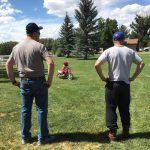
 there are two statues of horses eating the grass at the Quality Inn, and every time Reagan’s family drives by there, Reagan proceeds to tell those horses that they need to get back home to their corral. Now, don’t misunderstand me, she knows they are statues. She just likes saying that to be funny, and we all think it’s funny too.
there are two statues of horses eating the grass at the Quality Inn, and every time Reagan’s family drives by there, Reagan proceeds to tell those horses that they need to get back home to their corral. Now, don’t misunderstand me, she knows they are statues. She just likes saying that to be funny, and we all think it’s funny too.
Reagan likes mobility…of any kind. She rides horse, motorcycles, her truck, bicycle, and of course, the standard walking and running. And she’s pretty good at all of them. I think she was born riding something…or shortly thereafter. She takes everyone in her truck, or at least the ones that fit. I’m not totally sure how the dogs feel about it, but they ride along, so I guess she must be a pretty good driver. Reagan has grown up around a dad that loves motorcycles, a mom who loves horses, and an uncle who loves trucks, so none of this is particularly surprising to me. She has already had her first motorcycle accident, and while she had a shiner, she is a tough 
 girl, who doesn’t give up. She gets right back on and goes again. She loves hiking with her Oma, my sister-in-law, Jennifer Parmely, and riding her bicycle with her Aunt Brenda Schulenberg, who goes by BR. Together they all work on staying healthy and active. Reagan also loves to work with her grandparents, Albert and Kari Eighmy. They have safe tools for her to use, and she helps them build things around their farm. She loves having all of these people who let her help with things, because she likes to be busy. Today is Reagan’s 4th birthday. Happy birthday Reagan!! Have a great day!! We love you!!
girl, who doesn’t give up. She gets right back on and goes again. She loves hiking with her Oma, my sister-in-law, Jennifer Parmely, and riding her bicycle with her Aunt Brenda Schulenberg, who goes by BR. Together they all work on staying healthy and active. Reagan also loves to work with her grandparents, Albert and Kari Eighmy. They have safe tools for her to use, and she helps them build things around their farm. She loves having all of these people who let her help with things, because she likes to be busy. Today is Reagan’s 4th birthday. Happy birthday Reagan!! Have a great day!! We love you!!

 My niece, Ashley Parmely, who married my nephew, Eric five years ago, was raised largely in the country. She loved horses, dogs, and cats, which I knew, but what I didn’t know was that she really loves all animals. Since she and Eric bought a house next door to her parents, initially to be near her beloved horses, I have found out that her love of animals knows no bounds. She probably could have been a veterinarian. Ashley and Eric, now have goats, chickens, cows, and even little piggies. Some of these may belong to Ashley’s parents, but that makes no difference. Eric, Ashley, and their girls, Reagan and Hattie take care of the animals as much as anyone does. They just love being around the animals. Ashley is teaching her girls to take care of, and be gentle with the animals, and in turn the animals love the girls. It’s a beautiful thing to see, and Ashley treats us to lots of pictures of the her family with the different animals.
My niece, Ashley Parmely, who married my nephew, Eric five years ago, was raised largely in the country. She loved horses, dogs, and cats, which I knew, but what I didn’t know was that she really loves all animals. Since she and Eric bought a house next door to her parents, initially to be near her beloved horses, I have found out that her love of animals knows no bounds. She probably could have been a veterinarian. Ashley and Eric, now have goats, chickens, cows, and even little piggies. Some of these may belong to Ashley’s parents, but that makes no difference. Eric, Ashley, and their girls, Reagan and Hattie take care of the animals as much as anyone does. They just love being around the animals. Ashley is teaching her girls to take care of, and be gentle with the animals, and in turn the animals love the girls. It’s a beautiful thing to see, and Ashley treats us to lots of pictures of the her family with the different animals.
Lately, Ashley has been working to get her goats milk tested, because apparently if you are going to sell the milk, it has to pass a certain number of tests to show it is of good quality. I never knew that before, but I guess if you are around farm animals, and plan to make some money off of them, you have to find out all the quality control details first. Growing up with a farming background, Ashley knew that, and of course, her parents also did, so they could show her the ropes. Ashley and her little family are all working together to make their little farm a great success.
Of course, farming isn’t the only thing Ashley is about. She loves being a wife and mother, and her family’s happiness if her first priority. She is such a good mother…playing with the girls, and teaching them new things. 
 The girls like to go on walks and hikes with their parents, and Reagan, being in preschool, is learning new things including Spanish…but I’m getting ahead of myself, because that is tomorrow’s story. You see, four years ago, Ashley was given a wonderful, but one day late, birthday gift, when little Reagan arrived. Now her life is very busy with two very active little girls, and a farm full of animals. It’s a far cry from the single life she had before she and Eric were married, and one that makes her very happy. Today is Ashley’s birthday. Happy birthday Ashley!! Have a great day!! We love you!!
The girls like to go on walks and hikes with their parents, and Reagan, being in preschool, is learning new things including Spanish…but I’m getting ahead of myself, because that is tomorrow’s story. You see, four years ago, Ashley was given a wonderful, but one day late, birthday gift, when little Reagan arrived. Now her life is very busy with two very active little girls, and a farm full of animals. It’s a far cry from the single life she had before she and Eric were married, and one that makes her very happy. Today is Ashley’s birthday. Happy birthday Ashley!! Have a great day!! We love you!!
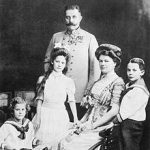
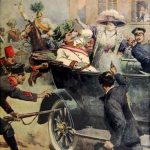 It’s amazing to me that one act of hate can bring so many people to war, but that was what happened with World War I. On June 28, 1914, Archduke Franz Ferdinand of Austria, and his wife, Sophie, Duchess of Hohenberg, were assassinated by a Serbian nationalist in Sarajevo, Bosnia. The assassin, Gavrilo Princip was an ethnic Serb and Yugoslav nationalist from the group Young Bosnia, which was supported by the Black Hand, a nationalist organization in Serbia. The outraged Austrian people and its government threatened mobilization of troops to seek vengeance for their beloved leader and his family.
It’s amazing to me that one act of hate can bring so many people to war, but that was what happened with World War I. On June 28, 1914, Archduke Franz Ferdinand of Austria, and his wife, Sophie, Duchess of Hohenberg, were assassinated by a Serbian nationalist in Sarajevo, Bosnia. The assassin, Gavrilo Princip was an ethnic Serb and Yugoslav nationalist from the group Young Bosnia, which was supported by the Black Hand, a nationalist organization in Serbia. The outraged Austrian people and its government threatened mobilization of troops to seek vengeance for their beloved leader and his family.
The crisis escalated as the conflict between Austria-Hungary and Serbia came to involve Russia, Germany, France, and ultimately Belgium and Great Britain. By mid-August of 1914, the crisis had become a full blown war, with Germany, Austria Hungary and the Ottoman Empire, known as the Central Powers, against Great Britain, France, Russia, Italy and Japan, the Allied Powers. The United States would also enter the war as a part of the Allied Powers in 1917. Other factors came into play during the diplomatic crisis that preceded the war, such as misperceptions of intent in that Germany believed that Britain would remain neutral, the belief that war was inevitable, and the speed of the crisis, which was exacerbated by delays and misunderstandings in diplomatic communications. The four years of the Great War…as it was dubbed…saw unprecedented levels of carnage and destruction, thanks to grueling trench warfare and the introduction of modern weaponry such as machine guns, tanks and chemical weapons. By the time World War I ended in the defeat of the Central Powers in November 1918, more than 9 million soldiers had been killed and 21 million more wounded.
Evil exists in this world, and it gets worse every day, and assassinations are not new. Chanakya, 350–283 BC, an Indian teacher, philosopher and royal advisor, wrote about assassinations in detail in his political treatise Arthashastra. Later, his student Chandragupta Maurya, the founder of the Maurya Empire of India, made use of assassinations against some of his enemies, including two of Alexander’s generals Nicanor and Philip. I suppose it should not be a surprise, yet every assassination brings with it shock, fear, and rage. 
 Countless wars have been fought over one nation’s ruler being killed by someone from another nation. War will be a part of our world until the end of time, but that in no way lessens the worry, fear, and sadness that war always brings. Still, like the Allies of World War I, we cannot let one group or nation hold power over another group or nation…which also explains the need to destroy ISIS.
Countless wars have been fought over one nation’s ruler being killed by someone from another nation. War will be a part of our world until the end of time, but that in no way lessens the worry, fear, and sadness that war always brings. Still, like the Allies of World War I, we cannot let one group or nation hold power over another group or nation…which also explains the need to destroy ISIS.
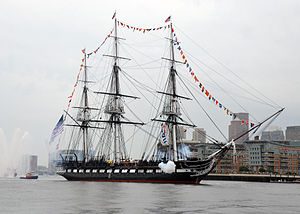 I think most of us have heard of the Barbary Coast at some point. The coast was named for its Berber inhabitants, but it was the trouble that occurred there that has made it a name to remember. The Barbary pirates, who were sometimes called Barbary corsairs or Ottoman corsairs, were pirates and privateers who operated from North Africa, mostly near the ports of Salé, Rabat, Algiers, Tunis, and Tripoli, which is now the area known as the Barbary Coast. In addition to seizing ships, they engaged in Razzias, raids on European coastal towns and villages, mainly in Italy, France, Spain, and Portugal, but also in the British Isles, the Netherlands and as far away as Iceland. Their main goal was to capture Christian slaves for the Ottoman slave trade, as well as the general Arabic market in North Africa and the Middle East. The pirates captured thousands of ships and repeatedly raided coastal towns.
I think most of us have heard of the Barbary Coast at some point. The coast was named for its Berber inhabitants, but it was the trouble that occurred there that has made it a name to remember. The Barbary pirates, who were sometimes called Barbary corsairs or Ottoman corsairs, were pirates and privateers who operated from North Africa, mostly near the ports of Salé, Rabat, Algiers, Tunis, and Tripoli, which is now the area known as the Barbary Coast. In addition to seizing ships, they engaged in Razzias, raids on European coastal towns and villages, mainly in Italy, France, Spain, and Portugal, but also in the British Isles, the Netherlands and as far away as Iceland. Their main goal was to capture Christian slaves for the Ottoman slave trade, as well as the general Arabic market in North Africa and the Middle East. The pirates captured thousands of ships and repeatedly raided coastal towns.
In order to combat the Barbary pirates, the United States Navy built the USS Constitution, which was a 44 gun  frigate. It was first launched on this day, October 21, 1797, from Boston Harbor. The USS Constitution performed well fighting off pirates in the area, and in 1805, a peace treaty was signed on her deck. When the conflict was over, the ship returned and to its base in Boston. I’m sure the pirates knew full well, that it would return if needed. The ship didn’t have to go back and flex it’s muscle again…at least not there.
frigate. It was first launched on this day, October 21, 1797, from Boston Harbor. The USS Constitution performed well fighting off pirates in the area, and in 1805, a peace treaty was signed on her deck. When the conflict was over, the ship returned and to its base in Boston. I’m sure the pirates knew full well, that it would return if needed. The ship didn’t have to go back and flex it’s muscle again…at least not there.
During the War of 1812, the USS Constitution won its nickname, Old Ironsides, after defeating the British warship, Guerriére in a furious battle off the coast of Nova Scotia. It was said that the British shots just bounced off the sides of the USS Constitution, as if they were made of iron, rather than wood, The Guerriére was thought to be invincible, but that was proven to be a fallacy. On the afternoon of 19 August 1812, about 400 miles southeast of Halifax, Nova Scotia, the Guerriére saw a sail in the distance, bearing down 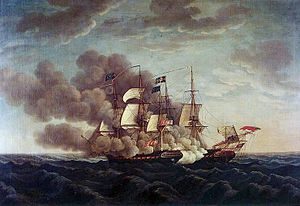 on them. It was the USS Constitution, so the Guerriére prepared for action. Captain James Dacres mustered 244 men and 19 boys, and set them to prepare for battle. When the enemy hoisted American colors, Captain Dacres permitted the Americans in his crew to quit their guns. When the fight was over, nine men were killed and thirteen were wounded. Captain Dacres surrendered his badly damaged ship in an effort to save the lives of the remaining crew, the crew were taken prisoner, and the crew of the USS Constitution set the ship on fire. That was the end of the Guerriére, and Old Ironsides was born. The USS Constitution was retired from service in 1881, and served as a receiving ship until designated a museum ship in 1907.
on them. It was the USS Constitution, so the Guerriére prepared for action. Captain James Dacres mustered 244 men and 19 boys, and set them to prepare for battle. When the enemy hoisted American colors, Captain Dacres permitted the Americans in his crew to quit their guns. When the fight was over, nine men were killed and thirteen were wounded. Captain Dacres surrendered his badly damaged ship in an effort to save the lives of the remaining crew, the crew were taken prisoner, and the crew of the USS Constitution set the ship on fire. That was the end of the Guerriére, and Old Ironsides was born. The USS Constitution was retired from service in 1881, and served as a receiving ship until designated a museum ship in 1907.
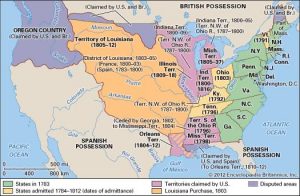 From the time the United States first declared their independence, there was a dispute over the border between the United States and its northern neighbor, Canada. In 1818, the situation finally got to a point whereby a final decision had to be made. It was determined that a convention needed to be held to handle the dispute. The convention, known as the London Convention, Anglo-American Convention of 1818, Convention of 1818, or simply the Treaty of 1818, was to discuss fisheries, boundary and the restoration of slaves between the United States of America and the United Kingdom of Great Britain and Ireland. The Treaty of 1818 was signed during the presidency of James Monroe, and it resolved the boundary between the United States and Canada, then owned by the United Kingdom, once and for all. The treaty allowed for joint occupation and settlement of the Oregon Country, known to the British and in Canadian history as the Columbia District of the Hudson’s Bay Company, and also took in New Caledonia, near Australia.
From the time the United States first declared their independence, there was a dispute over the border between the United States and its northern neighbor, Canada. In 1818, the situation finally got to a point whereby a final decision had to be made. It was determined that a convention needed to be held to handle the dispute. The convention, known as the London Convention, Anglo-American Convention of 1818, Convention of 1818, or simply the Treaty of 1818, was to discuss fisheries, boundary and the restoration of slaves between the United States of America and the United Kingdom of Great Britain and Ireland. The Treaty of 1818 was signed during the presidency of James Monroe, and it resolved the boundary between the United States and Canada, then owned by the United Kingdom, once and for all. The treaty allowed for joint occupation and settlement of the Oregon Country, known to the British and in Canadian history as the Columbia District of the Hudson’s Bay Company, and also took in New Caledonia, near Australia.
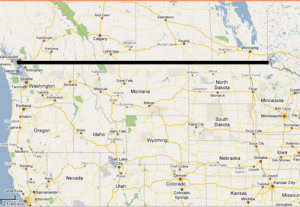
It was ultimately decided that the boundary line should be a straight one, because it would be easier to survey. The prior boundaries were based on watersheds, and were difficult to survey. The treaty marked both the United Kingdom’s last permanent major loss of territory in what is now the Continental United States and the United States’ only permanent significant cession of North American territory to a foreign power. Britain ceded all of Rupert’s Land south of the 49th parallel and west to the Rocky Mountains, including all of the Red River Colony south of that latitude, while the United States ceded the northernmost tip of the territory of Louisiana above the 49th parallel.
 Of course, the prior border from the Great Lakes to the east coast, was already established, so it isn’t straight, but the northwestern border is a straight line. I always thought that was odd, and didn’t know why it was that way. I don’t know if I was not paying attention in history class, which was not my favorite subject in my youth, although I don’t really know why it wasn’t, because now I find it quite fascinating. It’s interesting to find out that the northern border was simply a matter of convenience, and a bit of the barter system, if you will. In order to solve the border war, of sorts, Canada (United Kingdom) gave a little, and the United States gave a little. The end result was a clear cut border, and really, peaceful neighbors. I think the was a good way to settle things.
Of course, the prior border from the Great Lakes to the east coast, was already established, so it isn’t straight, but the northwestern border is a straight line. I always thought that was odd, and didn’t know why it was that way. I don’t know if I was not paying attention in history class, which was not my favorite subject in my youth, although I don’t really know why it wasn’t, because now I find it quite fascinating. It’s interesting to find out that the northern border was simply a matter of convenience, and a bit of the barter system, if you will. In order to solve the border war, of sorts, Canada (United Kingdom) gave a little, and the United States gave a little. The end result was a clear cut border, and really, peaceful neighbors. I think the was a good way to settle things.
 My Uncle Jim Richards has lead quite a life. After his dad passed away, when he was just eight years old, Uncle Jim took it upon himself to become the man of the house. In many ways, that decision was the beginning of many years of taking care of other people. Uncle Jim worked hard in school, and the people in his class and even some of the other classes really looked up to him. You could always count on Jim Richards. In fact there were a number of classmates who felt like they owed their life to Jim Richards. One boy, driving drunk, followed Jim home, and that was truly the only way he made it home. Of course, Uncle Jim didn’t know that, because he would have taken the boy home, if he had known. People knew that Uncle Jim was not driving drunk, because he set a standard of behavior at his high school in Bassett, Nebraska. He was also a track star there, having set records in hurdles, and several other sports. Uncle Jim would have made his dad very proud of the man he grew up to be. I don’t know if that thought occurred to him or not, but he would have accomplished that feat anyway. I’m sure that there were many times that Uncle Jim thought of his dad over the years, and what his dad would have done in a situation. I’m sure he did what he thought would make his dad, and his mom proud. Uncle Jim’s dad was a hard working man, working for the railroad for a number of years. I’m sure he instilled that same work ethic in his children. I know that his son Jim worked hard all his life, taking care of family members now and again, and helping out with his grandchildren, while his children worked.
My Uncle Jim Richards has lead quite a life. After his dad passed away, when he was just eight years old, Uncle Jim took it upon himself to become the man of the house. In many ways, that decision was the beginning of many years of taking care of other people. Uncle Jim worked hard in school, and the people in his class and even some of the other classes really looked up to him. You could always count on Jim Richards. In fact there were a number of classmates who felt like they owed their life to Jim Richards. One boy, driving drunk, followed Jim home, and that was truly the only way he made it home. Of course, Uncle Jim didn’t know that, because he would have taken the boy home, if he had known. People knew that Uncle Jim was not driving drunk, because he set a standard of behavior at his high school in Bassett, Nebraska. He was also a track star there, having set records in hurdles, and several other sports. Uncle Jim would have made his dad very proud of the man he grew up to be. I don’t know if that thought occurred to him or not, but he would have accomplished that feat anyway. I’m sure that there were many times that Uncle Jim thought of his dad over the years, and what his dad would have done in a situation. I’m sure he did what he thought would make his dad, and his mom proud. Uncle Jim’s dad was a hard working man, working for the railroad for a number of years. I’m sure he instilled that same work ethic in his children. I know that his son Jim worked hard all his life, taking care of family members now and again, and helping out with his grandchildren, while his children worked.
Times have changed to a degree for Uncle Jim, and for his wife, my Aunt Dixie, because all of their grandchildren are in school all day now, or grown up. They need a lot less care. That can be a lonely time, but always the caregivers, Uncle Jim and Aunt Dixie, do anything that is needed, from picking up the kids at times, to dropping off payments while the kids are at work, and generally just being there for whatever they are needed for. I’m sure that at times, they get weary, at times they feel lonely, and at times they aren’t sure just  what their role in life is supposed to be. I know this, because in many ways that is how I feel. So much has changed over the years, and the things we were needed for then, we aren’t now. But, that in no way diminishes the value we have as a person. Uncle Jim and Aunt Dixie are as valuable to their family as they ever were, and in fact even more. As our parents grow older, we start to truly understand how precious they are, and that is exactly how Jeannie, Jim, and Raylynn and their families feel about Uncle Jim and Aunt Dixie. They are precious to them. Today is Uncle Jim’s birthday. Happy birthday Uncle Jim!! Have a great day!! We love you!!
what their role in life is supposed to be. I know this, because in many ways that is how I feel. So much has changed over the years, and the things we were needed for then, we aren’t now. But, that in no way diminishes the value we have as a person. Uncle Jim and Aunt Dixie are as valuable to their family as they ever were, and in fact even more. As our parents grow older, we start to truly understand how precious they are, and that is exactly how Jeannie, Jim, and Raylynn and their families feel about Uncle Jim and Aunt Dixie. They are precious to them. Today is Uncle Jim’s birthday. Happy birthday Uncle Jim!! Have a great day!! We love you!!
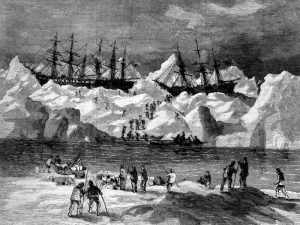 Over the centuries, many ships have been lost at sea, but it isn’t every day that 33 ships are lost together. That was the case in September of 1871, however, when the ice off of the coast of Alaska trapped 33 out of 40 commercial whaling ships who were hunting for bowhead whales in the Artic Ocean. Normally, when ice traps a ship, it eventually releases it’s grip with the shifting winds, but in this case that didn’t happen, and the results were disastrous. Within a few weeks, the ships were destroyed, and the families and crew members had to evacuate and head for one of the ships that was not trapped. As the 1,219 additional people boarded the remaining 7 ships, those ships became overloaded. They had to throw things overboard to allow for the extra weight. Things like their equipment and their precious cargo were lost. The already struggling whaling industry in the United States was basically dealt a final blow. The amazing thing was that no one died, but the loss of 33 ships over those weeks was devastating enough to the whaling industry.
Over the centuries, many ships have been lost at sea, but it isn’t every day that 33 ships are lost together. That was the case in September of 1871, however, when the ice off of the coast of Alaska trapped 33 out of 40 commercial whaling ships who were hunting for bowhead whales in the Artic Ocean. Normally, when ice traps a ship, it eventually releases it’s grip with the shifting winds, but in this case that didn’t happen, and the results were disastrous. Within a few weeks, the ships were destroyed, and the families and crew members had to evacuate and head for one of the ships that was not trapped. As the 1,219 additional people boarded the remaining 7 ships, those ships became overloaded. They had to throw things overboard to allow for the extra weight. Things like their equipment and their precious cargo were lost. The already struggling whaling industry in the United States was basically dealt a final blow. The amazing thing was that no one died, but the loss of 33 ships over those weeks was devastating enough to the whaling industry.
Not much was found of the ships for many years, although debris washed up on shore periodically. Still, no artifacts specifically tied to the shipwrecks could be found beneath beneath the water. In 2015, thanks to technological advances, archaeologists have found the wreckage of what appears to be two of the lost ships. They are located at the bottom of the Chukchi Sea off the coast of Wainwright, Alaska, but an exact location is not being given. Brad Barr, an archaeologist with the National Oceanic and Atmospheric Administration (NOAA), estimated the losses caused by what has been dubbed the Great Whaling Disaster of 1871 would have reached the equivalent of a little more than $33 million today. As Barr told LiveScience: “The event has been attributed as possibly a major contributory factor in the demise of whaling in the U.S.”
Barr began his hunt in late August 2015. He and a team of researchers from the Maritime Heritage Program of the NOAA’s Office of National Marine Sanctuaries surveyed the floor of the Chukchi Sea off the coast of the Inupiat village of Wainwright, in northwestern Alaska. They used state of the art sonar and underwater sensing technologies. They found the magnetic signatures of two shipwrecks they believe are part of the lost 1871 fleet, including the outlines of their flattened hulls. Underwater video revealed anchors, fasteners, pins, and ballast. They even discovered some of the special brick lined pots that the whalers used to heat the whale blubber to turn it into whale oil that was used to fire up oil lamps and make soap, margarine, and other products before the advent of petroleum. While the scientists can’t say definitively that the two wrecked ships were among the 33 lost in 1871, there are a lot of signs that point to it. More than half of all the ships known to have wrecked in the area went down in the 1871 event, and both wrecks, their beams and hull timbers were similar to those used in whaling ships from the late 19th century. The team was also aided in their efforts by changing sea ice levels, increasing opportunities to uncover lost shipwrecks even off Alaska’s northern coast. During the  expedition to the Chukchi Sea, the absence of ice was notable, and the archaeologists reportedly found artifacts from the wrecked ships “just sitting there” for them to find, Barr’s said. The team discovered remnants of a sandbar, which they believe protected the artifacts from sea ice. The NOAA is not really worried that the historic site will be disturbed, because historic preservation laws still apply. Also, there is no gold bullion, jewels or other precious cargo that might draw fortune hunters. Nevertheless, they are not publicizing the site’s exact location. Instead, they will provide all information to the Alaska Office of History and Archaeology, the agency in charge of protecting sites and relics in Alaska.
expedition to the Chukchi Sea, the absence of ice was notable, and the archaeologists reportedly found artifacts from the wrecked ships “just sitting there” for them to find, Barr’s said. The team discovered remnants of a sandbar, which they believe protected the artifacts from sea ice. The NOAA is not really worried that the historic site will be disturbed, because historic preservation laws still apply. Also, there is no gold bullion, jewels or other precious cargo that might draw fortune hunters. Nevertheless, they are not publicizing the site’s exact location. Instead, they will provide all information to the Alaska Office of History and Archaeology, the agency in charge of protecting sites and relics in Alaska.
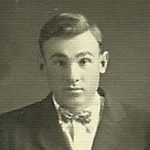 As a young boy of just 15 years, Andy Schulenberg was hunting with a friend, Howard Stewart on an October day in 1921. He leaned his rifle against a tree and it fell over, discharging and hitting Andy in the leg. That event would begin a 2 year long stay in the hospital, and Andy would lose his leg about a year into that stay, in June of 1922. While devastated over this event, Andy dug deep inside himself and decided that he would not be an invalid. Fitted with a wooden leg, that had a simple table like rubberized end to it, Andy proceeded to live the rest of his life. This would not break him, because he was not a quitter. Andy did whatever he wanted to do. Throughout his life, Andy did things his way. He became quite competitive. For a time, his family hauled beets, and Andy could out load anyone when it came to loading the truck. His arms were so strong, by way of compensation for his lack of a leg, and the fact that Andy was a big strong man. Many times while loading those trucks, he could load the truck he was working, faster than two men on the other truck…and then he went over and finished loading their truck too. Nobody could beat Andy Schulenberg!
As a young boy of just 15 years, Andy Schulenberg was hunting with a friend, Howard Stewart on an October day in 1921. He leaned his rifle against a tree and it fell over, discharging and hitting Andy in the leg. That event would begin a 2 year long stay in the hospital, and Andy would lose his leg about a year into that stay, in June of 1922. While devastated over this event, Andy dug deep inside himself and decided that he would not be an invalid. Fitted with a wooden leg, that had a simple table like rubberized end to it, Andy proceeded to live the rest of his life. This would not break him, because he was not a quitter. Andy did whatever he wanted to do. Throughout his life, Andy did things his way. He became quite competitive. For a time, his family hauled beets, and Andy could out load anyone when it came to loading the truck. His arms were so strong, by way of compensation for his lack of a leg, and the fact that Andy was a big strong man. Many times while loading those trucks, he could load the truck he was working, faster than two men on the other truck…and then he went over and finished loading their truck too. Nobody could beat Andy Schulenberg!
In 1955 Andy Schulenberg became the sheriff of Rosebud County, Montana. That was really an amazing feat for a man with a wooden peg for a leg. Andy became a sheriff who didn’t carry a gun. That is such an odd thing to think about. There might be a television show sheriff who didn’t need a gun, but the reality is that a real life sheriff carries a gun…at least any I knew of until Andy Schulenberg. You do have to recall that Andy maybe didn’t just love guns…making his decision to become a lawman a strange one, I suppose. I’m sure that most people must think that Andy lived in an area much like Mayberry on the Andy Griffith Show, but they would be wrong. Andy used different tools in his work as sheriff. He knew a lot of the Indian elders in the area, and they respected him. If Andy was looking for a specific brave, he would go to the elders and ask where he was. They would simply bring the young man to him. There are a number of young men who would be glad to tell you that had it not been for Andy Schulenberg, they would probably have ended up in prison. As I said, Andy was a different kind of sheriff. He believed in second chances, and he earned not only the respect of the elders, but of the young braves, and in fact all the young men and women in the area. He was honest and fair, and they knew they would get a fair shake from him.
There were some comical arrests, however. One in particular was the time Andy was called to Ashland, Montana. Two young Cheyenne Indians had decided to break into a liquor store. They made off with about a case of whiskey. They were down on the brush lined banks of Otter Creek when Andy caught up with them. On the reservation, Andy was known as Cottonwood, because of his wooden leg. When he found the young braves, 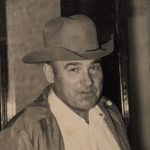 they were a little tipsy from the whiskey. They had crossed a log bridge to get to an island to have a little party. Andy cuffed the boys and told them to wait by the car. He went back for the evidence. On his way back, with several bottles of whiskey, Andy slipped and fell into the water. Under normal circumstances that might not have been a big deal, but wood floats, and Andy’s leg was made of wood. As he struggled to get his leg back under him without losing the evidence, the Indian braves sat on the side of the creek bank laughing hysterically. They assumed that the evidence would be lost, and they would get off scot-free, but they were wrong. Andy managed to get his leg under him, and save one bottle of whiskey. Then he took the braves…who had not even considered running, by the way, back to jail. And he did it all without a gun.
they were a little tipsy from the whiskey. They had crossed a log bridge to get to an island to have a little party. Andy cuffed the boys and told them to wait by the car. He went back for the evidence. On his way back, with several bottles of whiskey, Andy slipped and fell into the water. Under normal circumstances that might not have been a big deal, but wood floats, and Andy’s leg was made of wood. As he struggled to get his leg back under him without losing the evidence, the Indian braves sat on the side of the creek bank laughing hysterically. They assumed that the evidence would be lost, and they would get off scot-free, but they were wrong. Andy managed to get his leg under him, and save one bottle of whiskey. Then he took the braves…who had not even considered running, by the way, back to jail. And he did it all without a gun.
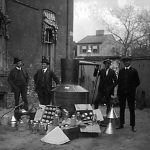
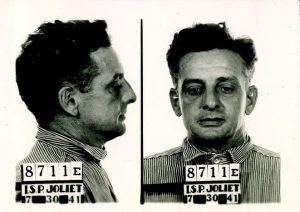 Many things that used to be illegal, are legal today…things like inter-racial marriage, marijuana (now legal in some states), and booze…believe it or not. Booze went from being legal, to being illegal in 1920, and back to legal in 1933. During those years while it was illegal, as with any law, there were those who broke the law and did it anyway. With booze, the problem, like with marijuana…because it was illegal, was no legal source for it. Enter the Bootlegger. Bootleggers, made their own booze and sold it on the black market of the day. The booze, often called Moonshine, was probably stronger than what booze would have been if it had been regulated and made legally, but an illegal product, is made to different standards, and often contains a much higher concentration than if it were legal.
Many things that used to be illegal, are legal today…things like inter-racial marriage, marijuana (now legal in some states), and booze…believe it or not. Booze went from being legal, to being illegal in 1920, and back to legal in 1933. During those years while it was illegal, as with any law, there were those who broke the law and did it anyway. With booze, the problem, like with marijuana…because it was illegal, was no legal source for it. Enter the Bootlegger. Bootleggers, made their own booze and sold it on the black market of the day. The booze, often called Moonshine, was probably stronger than what booze would have been if it had been regulated and made legally, but an illegal product, is made to different standards, and often contains a much higher concentration than if it were legal.
There have been a number of shows and movies that have almost romanticized bootlegging, but in reality, it was a highly dangerous occupation…if it could be called that. I’m sure there were a few non-violent  bootleggers…until they had to become violent to protect their stash and their territory. Men like Roger “The Terrible” Touhy, Al Capone, and Roy Olmstead (nicknamed the “King of the Puget Sound Bootleggers”), did everything in their power to bring liquor to those who wanted it…for a price, of course. They had to make a profit and hazard pay was essential too. Early bootleggers smuggled European liquor in, but that quickly became very dangerous, so the bootleggers started to make their own. Every time the prohibition officers caught a bootlegger, the liquor was disposed of…often into the sewer drains. Prohibition officers went everywhere. They were in the cities and the country…anywhere that their intel indicated that a bootlegger had a still in the area. The Temperance Society insisted that they remove every drop of the “demon liquor” from this country. They were convinced that liquor was the root of all evil…so to speak.
bootleggers…until they had to become violent to protect their stash and their territory. Men like Roger “The Terrible” Touhy, Al Capone, and Roy Olmstead (nicknamed the “King of the Puget Sound Bootleggers”), did everything in their power to bring liquor to those who wanted it…for a price, of course. They had to make a profit and hazard pay was essential too. Early bootleggers smuggled European liquor in, but that quickly became very dangerous, so the bootleggers started to make their own. Every time the prohibition officers caught a bootlegger, the liquor was disposed of…often into the sewer drains. Prohibition officers went everywhere. They were in the cities and the country…anywhere that their intel indicated that a bootlegger had a still in the area. The Temperance Society insisted that they remove every drop of the “demon liquor” from this country. They were convinced that liquor was the root of all evil…so to speak.
The bootleggers quickly became Mob leaders with their own gangs, and crossing them quickly became very dangerous. They would even frame or kill their competition, in fact it happened often. Al Capone framed Roger Touhy for kidnapping by his bootlegging rivals with the help of corrupt Chicago officials, was serving a 99-year sentence for a kidnapping he did not commit. He was recaptured a couple of months later. The two men hated each other bitterly, and when it was finally proven that Touhy had been framed, he was released. Three weeks 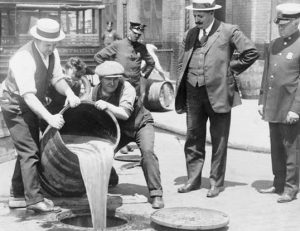
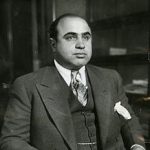 later as he walked into his sister’s house, Touhy was gunned down. Right before he died, he said, “I’ve been expecting it. The b*******s never forget.” No arrests were made. I wonder if anyone really tried. Those were dangerous times, and one gang often retaliated against another. Even after Prohibition was repealed in 1933, bootleggers did not become extinct, because there were still counties and cities who continued Prohibition. Where there is a law, there are lawbreakers.
later as he walked into his sister’s house, Touhy was gunned down. Right before he died, he said, “I’ve been expecting it. The b*******s never forget.” No arrests were made. I wonder if anyone really tried. Those were dangerous times, and one gang often retaliated against another. Even after Prohibition was repealed in 1933, bootleggers did not become extinct, because there were still counties and cities who continued Prohibition. Where there is a law, there are lawbreakers.
 While people might not know that today, October 14 was the day that Air Force test pilot, Chuck Yeager became the first person to break the sound barrier, many do know that it was Chuck Yeager who accomplished that feat. That was back in 1947, and it was an amazing accomplishment in speed flying…an activity common to test pilots, though not always safe or successful, and sometimes deadly. There was also another record that was broken on this day, but this one was back in 2012.
While people might not know that today, October 14 was the day that Air Force test pilot, Chuck Yeager became the first person to break the sound barrier, many do know that it was Chuck Yeager who accomplished that feat. That was back in 1947, and it was an amazing accomplishment in speed flying…an activity common to test pilots, though not always safe or successful, and sometimes deadly. There was also another record that was broken on this day, but this one was back in 2012.
Felix Baumgartner was born in Salzburg, Austria in 1969, and he started skydiving when he was 16 years old. He was also a paratrooper during his time in the Austrian Army. After his time in the Army, Felix decided that he needed that kind of excitement in his life, and so he went on to perform a series of daredevil feats, including becoming the first person to jump from one of the twin 1,483 foot high Petronas Towers in Kuala Lumpur, then the world’s tallest buildings, in 1999, and becoming the first person to skydive across the English Channel using a carbon-fiber wing, in 2003. His next record breaking jump was going to be his greatest feat, however, and it was five years in the making. It also involved a team of engineers, scientists, and aeronautic experts to custom design his equipment, including his pressurized space suit (intended to prevent his blood from boiling at high altitudes) and 6 foot wide, 2,900 pound, pressurized capsule. I’m sure that by now you are wondering why he would need such equipment, but I  assure you that he did. In 2010 the project, which was financed by energy drink company Red Bull, hit a roadblock when Baumgartner started having panic attacks while undergoing endurance tests in his pressurized suit and helmet. A sports psychologist eventually helped him learn to cope with his claustrophobia. I find it amazing that a dare devil would have such a problem as claustrophobia, but remember that he was a sky diver, so he was used to wide open spaces. This project required that he have a capsule that was attached to a helium balloon to take Baumgartner to an incredible height of 24 miles above the Earth.
assure you that he did. In 2010 the project, which was financed by energy drink company Red Bull, hit a roadblock when Baumgartner started having panic attacks while undergoing endurance tests in his pressurized suit and helmet. A sports psychologist eventually helped him learn to cope with his claustrophobia. I find it amazing that a dare devil would have such a problem as claustrophobia, but remember that he was a sky diver, so he was used to wide open spaces. This project required that he have a capsule that was attached to a helium balloon to take Baumgartner to an incredible height of 24 miles above the Earth.
At this point, I’m sure you are curious about the planned jump. On that morning, October 14, 2012, a 550 foot high helium balloon made of 40 acres of ultrathin plastic lifted the capsule carrying Baumgartner, nicknamed Fearless Felix by the crew at the launch site at Roswell International Air Center. He was going to jump from the capsule  at 127,852.4 feet and plunge to Earth. It would be the highest distance anyone had ever skydived from, and it would take nine minutes and eighteen seconds, of which four minutes and twenty seconds would be free fall…without an opened parachute…during which time he fell 119,431 feet. The prior record for high altitude skydiving was held by Joseph Kittinger, who jumped from an altitude of 102,800 feet in 1960. Kittinger was a former Air Force colonel, and was part of the team that helped prepare Baumgartner for his record breaking jump. Baumgartner’s top speed during that free fall was 843.6 miles per hour, or Mach 1.25, making Fearless Felix not only the record holder for the highest skydive, but now he was also the first person to break the sound barrier without the protection or propulsion of a vehicle. The capsule was equipped with cameras, to record the event, which was broadcast on the internet and on television, so it could be witnessed by millions of people world wide. After the jump, Fearless Felix landed safely in the desert near Roswell, New Mexico.
at 127,852.4 feet and plunge to Earth. It would be the highest distance anyone had ever skydived from, and it would take nine minutes and eighteen seconds, of which four minutes and twenty seconds would be free fall…without an opened parachute…during which time he fell 119,431 feet. The prior record for high altitude skydiving was held by Joseph Kittinger, who jumped from an altitude of 102,800 feet in 1960. Kittinger was a former Air Force colonel, and was part of the team that helped prepare Baumgartner for his record breaking jump. Baumgartner’s top speed during that free fall was 843.6 miles per hour, or Mach 1.25, making Fearless Felix not only the record holder for the highest skydive, but now he was also the first person to break the sound barrier without the protection or propulsion of a vehicle. The capsule was equipped with cameras, to record the event, which was broadcast on the internet and on television, so it could be witnessed by millions of people world wide. After the jump, Fearless Felix landed safely in the desert near Roswell, New Mexico.

